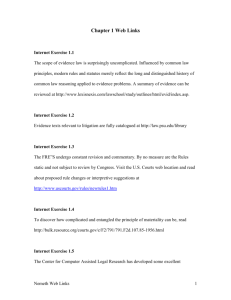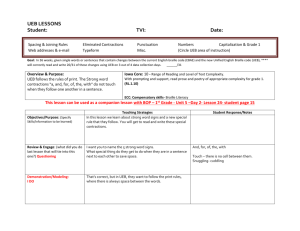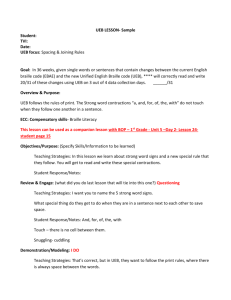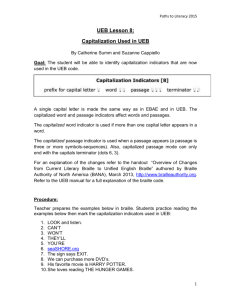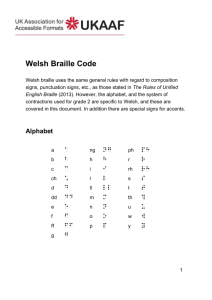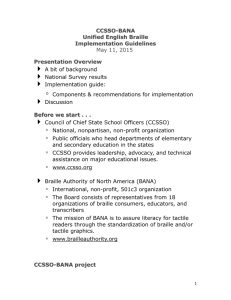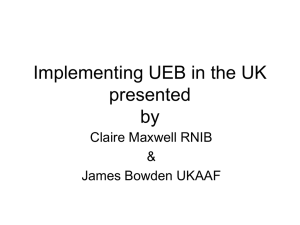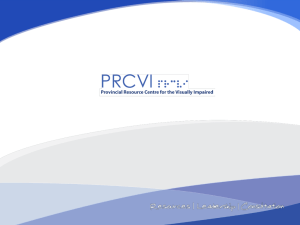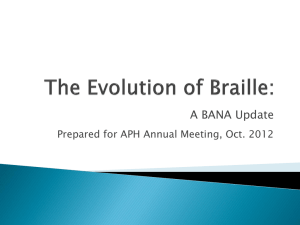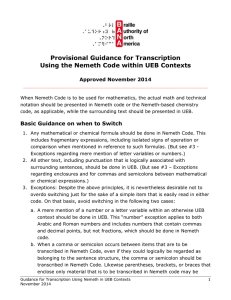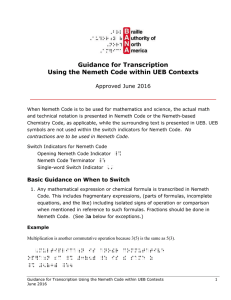report of the bana task force on concurrent use of ueb and nemeth
advertisement
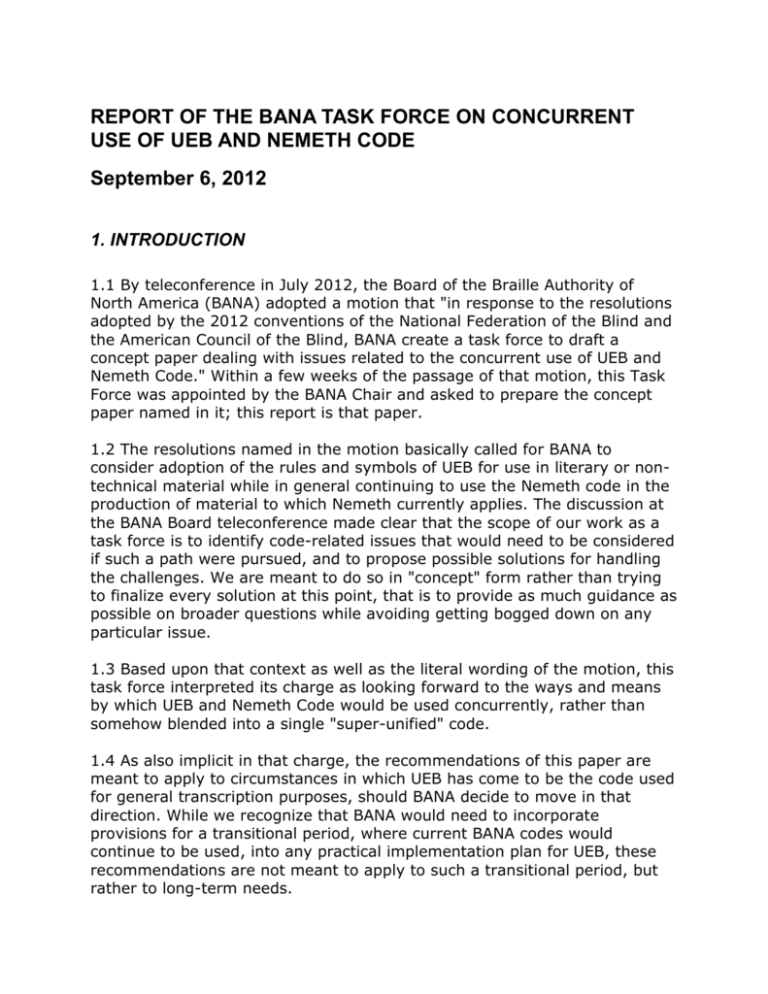
REPORT OF THE BANA TASK FORCE ON CONCURRENT
USE OF UEB AND NEMETH CODE
September 6, 2012
1. INTRODUCTION
1.1 By teleconference in July 2012, the Board of the Braille Authority of
North America (BANA) adopted a motion that "in response to the resolutions
adopted by the 2012 conventions of the National Federation of the Blind and
the American Council of the Blind, BANA create a task force to draft a
concept paper dealing with issues related to the concurrent use of UEB and
Nemeth Code." Within a few weeks of the passage of that motion, this Task
Force was appointed by the BANA Chair and asked to prepare the concept
paper named in it; this report is that paper.
1.2 The resolutions named in the motion basically called for BANA to
consider adoption of the rules and symbols of UEB for use in literary or nontechnical material while in general continuing to use the Nemeth code in the
production of material to which Nemeth currently applies. The discussion at
the BANA Board teleconference made clear that the scope of our work as a
task force is to identify code-related issues that would need to be considered
if such a path were pursued, and to propose possible solutions for handling
the challenges. We are meant to do so in "concept" form rather than trying
to finalize every solution at this point, that is to provide as much guidance as
possible on broader questions while avoiding getting bogged down on any
particular issue.
1.3 Based upon that context as well as the literal wording of the motion, this
task force interpreted its charge as looking forward to the ways and means
by which UEB and Nemeth Code would be used concurrently, rather than
somehow blended into a single "super-unified" code.
1.4 As also implicit in that charge, the recommendations of this paper are
meant to apply to circumstances in which UEB has come to be the code used
for general transcription purposes, should BANA decide to move in that
direction. While we recognize that BANA would need to incorporate
provisions for a transitional period, where current BANA codes would
continue to be used, into any practical implementation plan for UEB, these
recommendations are not meant to apply to such a transitional period, but
rather to long-term needs.
1.5 In light of the above, this task force, meeting by email list and
conference calls, considered two primary questions, i.e.: (1) by what means
it would be possible for UEB and Nemeth Code to coexist, and (2) in a world
in which the two codes coexist, in what context each should be used. We
reached general consensus as given below.
2. FINDINGS AND RECOMMENDATIONS REGARDING UEB AND
NEMETH CODE
2.1 How Can UEB and Nemeth Code Coexist?
2.1.1 The task force noted that Nemeth Code (i.e. the 1972 standard as
maintained and updated, including the Chemistry Code) is characterized by
two distinct "modes," one intended for actual math and related technical
notation, and the other for surrounding English-language text. While
mentioned explicitly with respect to punctuation in Nemeth rule 36, these
modes also affect such matters as capitalization and emphasis, as implied in
other rules. Most noticeably, English contractions are not used in math mode
though they are generally used, albeit with some special restrictions, in the
surrounding-text mode. In any event, by means of these two modes,
Nemeth Code provides a way for math and related scientific notation and
general text to coexist in the same document.
2.1.2 UEB provides general "switching" mechanisms by which codes other
than UEB, including Nemeth Code as well as foreign languages, music, etc.,
may be incorporated into a general UEB context without ambiguity.
Examples of switching into Nemeth Code are included in a pending (recently
approved though not yet published) update to the UEB Rulebook. In the
following example excerpted from the rulebook, the first and last indicators
are the opening and closing non-UEB passage indicators. Although these
indicators can currently be used in UEB for entering and exiting Nemeth
code, specific Nemeth indicators which use fewer cells are proposed later in
this paper.
Solution. Again we group the first two terms and the last two terms.
4x – 12x2 – x + 3
= 4x2(x – 3) – (x – 3)
= (x – 3)(4x2 – 1)
= (x – 3)(2x + 1)(2x – 1).
3
.1,solu;n4 ,ag we gr\p ! f/
two t]ms & ! la/ two t]ms4
"('
#4x^3"-12x^2"-x+3
.k #4x^2"(x-3)-(x-3)
.k (x-3)(4x^2"-1)
.k (x-3)(2x+1)(2x-1)_4
,")
2.1.3 These mechanisms therefore provide two possible means by which
math in Nemeth Code and general text in UEB can coexist in the same
document. Of these two possibilities, this task force recommends that
Nemeth code be used for the actual math or technical notation, and UEB be
used for the surrounding text. Our observations and reasons for this
recommendation are detailed in sections 2.1.4-2.1.8.
2.1.4 When people say they are accustomed to Nemeth code for math, they
are virtually always speaking of the math mode, not the surrounding-text
mode. This is clear from the examples brought forward to oppose the
adoption of UEB, which are generally drawn from secondary-school or
college level algebra, calculus, or chemical formulas with little or no notice of
surrounding text. This makes sense because Nemeth Code (math mode) is
naturally designed with its primary focus on algebraic notation (in the
general sense, which includes related "higher" notation such as differential
equations), especially when letters (as opposed to words) are used as
variables. In such math notation, Nemeth code provides single-cell
representations for common mathematical signs and structures such as the
plus sign, indices, and radical and fraction boundaries. It also takes
advantage of the relative scarcity of punctuation marks in such notation and
uses lower signs for digits, thus reducing the number of indicators that
might otherwise be needed when digits and letters are juxtaposed.
Consequently, algebraic math notation with single-letter variables typically
takes fewer cells to express in Nemeth math mode than in codes such as
UEB that are designed with a broader focus.
Nemeth math mode is also relatively unambiguous in representing the
salient content of that kind of notation. (There is a well-known exception in
that the lowercase Greek kappa and the equals sign have the same
representation, but that is seldom a practical difficulty in most algebraic
math, probably because the kappa so closely resembles a lowercase Latin k
that it takes extra effort to make the distinction in common forms of print,
especially handwriting on a blackboard. There is a listing of the accepted
uses of the kappa in the online Wikipedia article on "Greek letters used in
mathematics, science, and engineering"; all of the listed uses are relatively
narrow and infrequently encountered in math generally.)
These features -- compactness without loss of clarity in math -- are the
primary strengths of Nemeth Code and what people are seeking to preserve
in situations where intense immersion in math notation is envisioned.
2.1.5 By contrast, the provisions in Nemeth Code for surrounding text are
focused not so much on compactness nor clarity but rather are intended to
adapt the then-current North American literary code (i.e. English Braille
American Edition [EBAE]) for the somewhat specialized needs of Englishlanguage text surrounding math notation, while preserving most of the
literary provisions, including most contractions in most circumstances. While
this focus is relevant to EBAE readers, it would not be particularly relevant to
future UEB readers.
2.1.6. One reason for not continuing to use the Nemeth provisions for
surrounding text is that they can lead to ambiguous braille -- even beyond
cases (e.g. those related to short-forms) that could be considered as
inherited from EBAE. For example, the use of the Nemeth math parentheses,
which normally stand for "of" and "with" in a literary context, can create
ambiguities, not all of which are corrected by Nemeth rule 55e. For instance,
"forthwith" and "forth)" are identical in Nemeth surrounding-text mode.
While a human reader would very likely be able to utilize context to sort out
which meaning is intended, such ambiguities can impact those users who
compose material in braille and who rely upon automated conversion to
produce print for sighted teachers, students or colleagues.
2.1.7 A second problem for Nemeth surrounding-text mode is that, as in
EBAE and Nemeth math mode, computer notation cannot be accurately
represented. This was the reason that it was necessary to develop CBC in
the mid-1980s. Thus it would be necessary to switch to CBC or UEB when
sample computer programs or similar inclusions of computer notation, even
ordinary URLs, were encountered in otherwise math-oriented material.
2.1.8 The third reason for not continuing to use the Nemeth surroundingtext mode after general adoption of UEB is that it would constitute a step
back to an earlier literary standard that has been supplanted, which would
be at least detrimental and potentially confusing to readers. The differences
between EBAE and UEB include the nine discontinued contractions in UEB
and affect such things as capitalization and emphasis. The extent of numeric
mode, and the usage rules for short-forms as well as certain symbols such
as brackets are also impacted. While the thought might come to mind that
UEB could be modified similarly to the way that EBAE is modified in current
Nemeth surrounding-text mode, e.g. substituting Nemeth-style parentheses,
etc., such an idea was judged impractical because the cascading changes
that would be necessary to produce a clear code would be so numerous,
even if they could be worked out, that the result would be so far afield from
either UEB or Nemeth Code that it would be impossible to integrate Nemeth
Code into UEB. Let each code be used concurrently, rather than trying to
modify either one to somehow suit the other.
2.1.9 If UEB is used as the primary code according to this recommendation,
there remains the question as to whether "switching" between UEB and
Nemeth should be formal and explicit, as presented in the UEB Rulebook, or
by using some other method. The task force considered three possibilities:
2.1.10 The first possibility is to omit any explicit switches, simply using
Nemeth code (math mode) as applicable and UEB for all else. This minimizes
cell count, is consistent with the way that the two modes of Nemeth Code
are presently used, and is probably suitable for many human readers who
would be familiar with both UEB and Nemeth (math mode) and the general
subject matter. It does mean that many expressions would be formally
ambiguous, and there is a chance that such ambiguity could sometimes be
confusing even for human readers. For example, "rings"
r+s and "r+s"
r+s would appear the same in such mixed braille (as they currently do in
Nemeth Code), but as noted above, such ambiguities are usually sorted out
easily enough by experienced readers.
2.1.11 The second possibility would be to incorporate an unobtrusive clue
which would alert the human reader to when a code change occurs e.g. two
spaces instead of one when such a code change would take place inline, and
a skipped line to accommodate displayed expressions (as in current CBC).
Such a provision would not eliminate the formal ambiguity problem entirely,
but it could prove useful for some readers, especially for those just getting
into a subject area.
2.1.12 The third possibility would be to provide for an explicit switch at each
change. While probably overkill in cases where a transcription is intended
only for human consumption (as are most), it would certainly be necessary
to provide for switches when a user is preparing mixed-code braille that is
intended to be converted to print by automated means. The existing
general-purpose switch that UEB provides is rather cumbersome for frequent
use since it is at least three cells long. If Nemeth Code is to be used
commonly as an adjunct code to UEB, then it would be possible to assign
specific and unambiguous two-cell switches for this purpose. We noted that
the begin- and end-Nemeth Code symbols from CBC, i.e. dots 456-146 and
456-156 respectively, would be suitable not only in terms of BANA history
(as they are also referenced in the current Formats Guidelines) but also
available given current UEB and Nemeth code assignments. (Dots 456-146
has no current meaning in UEB and therefore could be used in UEB to signal
the beginning of a Nemeth code passage. Likewise, 456-156 has no current
meaning in Nemeth math mode and could be used within Nemeth code to
indicate a switch back from Nemeth to UEB.) As has been the case with
previous requests, such as for the assignment of the copyright symbol, we
expect that the ICEB UEB maintenance committee will be receptive to a
request from BANA to reserve assignment of the 456-146 symbol as a
"begin Nemeth Code" indicator.
2.2 In What Contexts Should Each Code be Used?
2.2.1 We agreed that this is a very broad question, the answer to which
could not be fully developed by this task force because it involves such
matters as educational philosophy and personal preference that will require
consultation and experience over a possibly lengthy period of time. Our
general recommendation to BANA, therefore, is to avoid being overly
prescriptive, even though some guidelines will no doubt need to be
developed as part of any UEB implementation plan.
2.2.2 Concerns were raised, however, that any guidelines would need to
ensure that students' school work would be transcribed in the same code
that would be used for brailling their tests -- especially high-stakes tests,
which may be produced by an entirely separate entity from that which
produces the school work.
3. DISCUSSION REGARDING FUTURE ROLE FOR COMPUTER
BRAILLE CODE
3.1 Although not directly mentioned in the charges, we also briefly
considered the possible continued use of BANA's Computer Braille Code
(CBC) for certain transcriptions of computer notation. Some task force
participants noted that, within its target domain of notation, CBC holds, at
least in theory, special advantages that essentially parallel those of Nemeth
Code within algebraic math, and therefore BANA might want to contemplate
its continued use in some special circumstances. After discussion, this task
force agreed that there is no particular need to take any action regarding
CBC even if UEB is adopted. Programmers who wish to do so can of course
use CBC for their purposes regardless of its "official" status, as it is a welldefined and mature code that has changed little since its original
development. There would probably be no need for a standing BANA CBC
committee, as the only issues that have come to that committee's attention
in recent years have involved the interaction between CBC and literary code
for surrounding context, e.g. the use or non-use of the CBC continuation
indicator.
4. SUMMARY OF FINDINGS AND RECOMMENDATIONS
The use of Nemeth Code with UEB should be relatively straightforward.
The recommendations in this paper are meant to apply to long-term
needs rather than to any transition period which may be necessary as
part of an implementation plan.
When Nemeth Code is to be used for mathematics, the actual math (and
technical notation) should be presented in Nemeth code, while the
surrounding text should be presented in UEB.
Three viable possibilities exist for moving between mathematical
expressions and their surrounding text:
1) Use no formal switch mechanism as is the case in the current Nemeth
code;
2) use multiple spaces or line breaks to signal the switch; or
3) use explicit indicators such as dots 456-146 as a "begin-Nemeth"
indicator and dots 456-156 to return to UEB.
The matter of when to use which codes is a broad question which will
need to be answered as part of the larger implementation plan. BANA
should avoid being overly prescriptive but develop guidelines that ensure
that, for example, students' schoolwork will be transcribed in the same
manner as their tests.
Respectfully submitted,
The BANA Task Force on Concurrent use of UEB and Nemeth Code:
Chair: Jennifer Dunnam
Consultant: Darleen Bogart
Members: Kim Charlson, Judy Dixon, Cindi Laurent, Joe Sullivan
(This report was accepted by the board of the Braille Authority of
North America on September 10, 2012).
